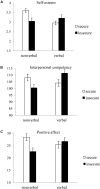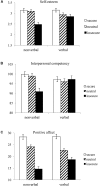Effects of Non-verbal Priming on Attachment-Style Activation
- PMID: 31024376
- PMCID: PMC6459896
- DOI: 10.3389/fpsyg.2019.00684
Effects of Non-verbal Priming on Attachment-Style Activation
Abstract
Using an affective priming procedure, two experiments examined the effects of non-verbal cues on activating attachment styles. In Study 1, the secure attachment group, which was primed non-verbally, showed higher levels of self-esteem, interpersonal competence, and positive affect than the insecure attachment group, which was also primed non-verbally. In contrast, no significant difference was found between the two attachment groups that were primed verbally. In Study 2, using a different priming method and adding a neutral group, similar interactions between priming modality (non-verbal or verbal cues) and attachment styles were found: the differences in self-esteem, interpersonal competence, and positive affect between the secure attachment group, neutral group, and insecure attachment group were greater when primed non-verbally than when primed verbally. Finally, the limitations of the research and recommendations for follow-up study are discussed.
Keywords: affective priming; attachment style; interpersonal competency; non-verbal cues; positive affect; self-esteem.
Figures


References
-
- Ainsworth M. D. S., Blehar M. C., Waters E., Wall S. (1978/2015). Patterns of Attachment: Assessed in the Strange Situation and at Home. Hillsdale, NJ: Erlbaum.
-
- American Psychiatric Association [APA] (2013). Diagnostic and Statistical Manual of Mental Disorders, DSM-5, 5th Edn Washington, DC: American Psychiatric Association; 10.1176/appi.books.9780890425596 - DOI
-
- Anthony D. B., Wood J. V., Holmes J. G. (2007). Testing sociometer theory: self-esteem and the importance of acceptance for social decision-making. J. Exp. Soc. Psychol. 43 425–432. 10.1016/j.jesp.2006.03.002 - DOI
LinkOut - more resources
Full Text Sources

